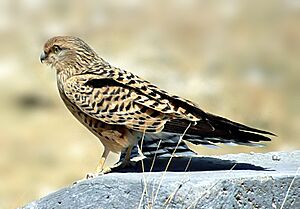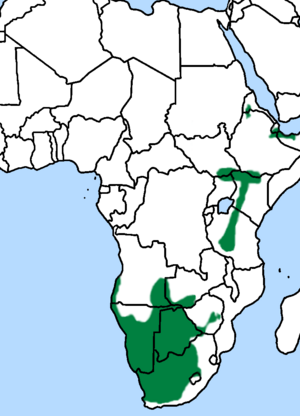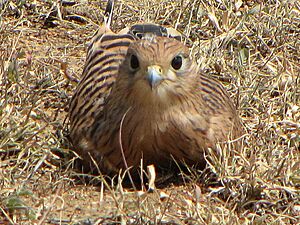Greater kestrel facts for kids
Quick facts for kids Greater kestrel |
|
|---|---|
 |
|
| Conservation status | |
| Scientific classification | |
| Genus: |
Falco
|
| Species: |
rupicoloides
|
 |
|
The greater kestrel (which scientists call Falco rupicoloides) is a cool bird of prey from the falcon family. It's also known as the white-eyed kestrel because of its unique eye color! This bird is one of the biggest kestrels around. You can find it flying over open lands in southern and eastern Africa.
Contents
What Does the Greater Kestrel Look Like?

Adult greater kestrels are mostly a pale reddish-brown color, both on their backs and undersides. Their backs, upper wings, and sides have black stripes. Their chests have dark streaks, and their heads are streaked too. Unlike some other kestrels, they don't have a dark stripe near their eyes.
Their lower back and tail are grey with black stripes, and the tail has a white tip. When they fly, their light-colored underwings stand out against their darker bodies. A special feature is their whitish eyes, which helps tell them apart from similar birds. Their beak is mostly blue-grey, and their feet and the waxy part above their beak (called the cere) are yellow.
Young kestrels have reddish tails instead of grey ones. They also have streaked sides and dark eyes.
These birds are about 29 to 37 centimeters (11 to 15 inches) long. Their wings can spread out from 68 to 84 centimeters (27 to 33 inches) wide. Kestrels in the southern parts of Africa weigh about 181 to 334 grams (0.4 to 0.7 pounds). Those found further north are a bit smaller and lighter in color.
Greater kestrels are usually quiet. But sometimes, they make a loud, sharp call that they repeat.
Where Do Greater Kestrels Live?
This kestrel lives in open, dry places. You can find them in grasslands, savannas (grassy areas with scattered trees), and semi-deserts. They often hang out near acacia trees. They like areas where the grass or plants on the ground are shorter than 50 centimeters (about 20 inches). They can live from sea-level up to 2,150 meters (about 7,000 feet) high, but they prefer areas between 800 and 1,800 meters (2,600 to 5,900 feet).
Greater kestrels are quite common in the southern parts of their home range. However, they are harder to find and live in smaller, spread-out groups further north.
You can find them breeding in countries like Namibia, Botswana, Zimbabwe, parts of Angola and Zambia, and most of South Africa. They avoid the very wet areas of South Africa. Other groups of greater kestrels live in Kenya, northern Tanzania, Ethiopia, Eritrea, northern Somalia, and possibly northern Kenya.
Their total home area is huge, covering about 3.5 million square kilometers (about 1.35 million square miles). There are likely between 100,000 and 200,000 pairs of these birds, and their numbers are stable. Most greater kestrels stay in one place, but some travel around or move to new areas.
What Do Greater Kestrels Eat?
The greater kestrel usually hunts from a high spot, like a tree branch or a rock. They also have a cool hunting trick: they can hover in the air, staying in one place while looking for food below, just like some other kestrels.
They mostly eat invertebrates, which are creatures without backbones. This includes grasshoppers, termites, beetles, and solifugids (which are like large, fast spiders). They also catch lizards and sometimes small birds, mammals, and even tiny snakes. They usually grab their prey right off the ground.
These birds are often drawn to fires. As insects and other small animals try to escape the flames, the kestrels swoop in to catch them. If they catch more food than they can eat, they might hide the extra under plants or stones for later.
Reproduction and Life Cycle

The time when greater kestrels breed changes depending on where they live. In the southern parts of Africa, they breed from July to April, with most babies born between September and December. In Kenya and Tanzania, they can breed all year, but it's most common from April to July. In Somalia, the breeding season is from April to August.
Greater kestrels don't build their own nests. Instead, they use old nests made by other birds, like those of a Cape crow or pied crow. They usually choose a nest that is 2 to 20 meters (about 6 to 65 feet) high in a tree. Sometimes, they even use nests on telephone poles or power pylons.
A female kestrel usually lays two to seven eggs, but three or four eggs are most common. The eggs are kept warm (this is called incubation) for 22 to 23 days, mostly by the female bird. The young birds are ready to fly (this is called fledging) after 30 to 34 days. Even after they can fly, they stay with their parents and depend on them for at least 26 more days.


